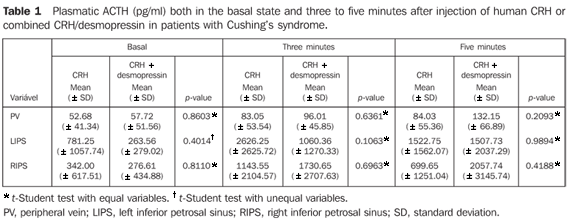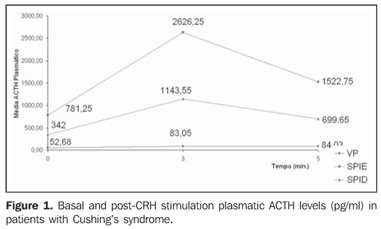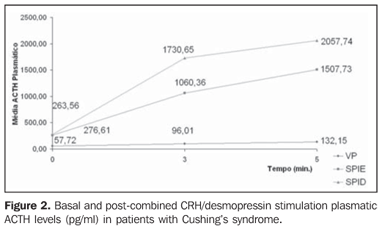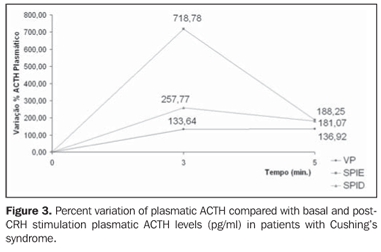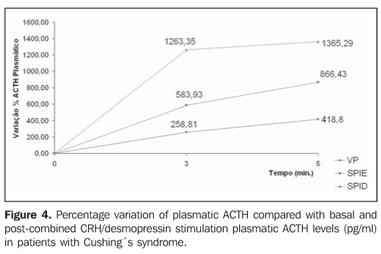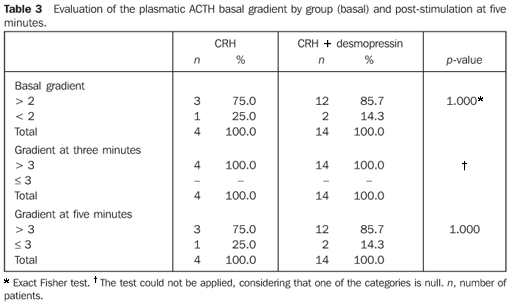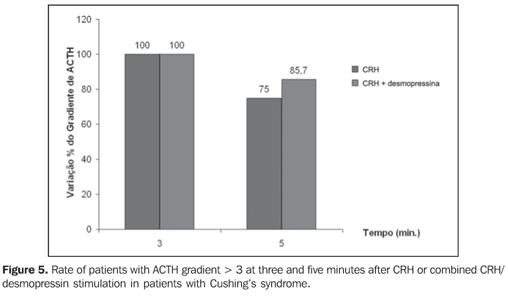Radiologia Brasileira - Publicação Científica Oficial do Colégio Brasileiro de Radiologia
AMB - Associação Médica Brasileira CNA - Comissão Nacional de Acreditação
 Vol. 40 nº 6 - Nov. / Dec. of 2007
Vol. 40 nº 6 - Nov. / Dec. of 2007
|
ORIGINAL ARTICLE
|
|
Response of plasmatic ACTH to CRH or combined CRH/desmopressin stimulation in patients with ACTHdependent Cushing's syndrome submitted to simultaneous bilateral petrosal sinuses sampling |
|
|
Autho(rs): Daniella Maria Carneiro do Rêgo, Francisco Bandeira, Carlos Abath, Gustavo Andrade, Hildo Azevedo |
|
|
Keywords: Cushing's syndrome, CRH, Desmopressin, Petrosal sinus sampling |
|
|
Abstract:
INTRODUCTION Endogenous Cushing's syndrome results from chronic, excessive exposure to glucocorticoids produced by the adrenal cortex. This disease may be caused by the excessive secretion of ACTH (80% to 85%), usually by an ACTH-secreting corticotrophic adenoma (Cushing's syndrome) and, less frequently, by an extrapituitary tumor (ectopic ACTH syndrome), or, very rarely, by a CRH-secreting tumor (ectopic CRH syndrome). Cushing's syndrome also may be ACTH-independent (15% to 20%) when resulting from excessive cortisol secretion by benign or malignant unilateral adrenocortical tumors or by bilateral adrenal hyperplasia(1,2). Because of biochemical parameters and non-specific clinical manifestations variability, the diagnosis represents a challenge for clinicians(1,2). Studies show that combined CRH/desmopressin is more effective than isolate CRH to increase ACTH levels in peripheral venous samples of patients with Cushing's syndrome(1). However, scarce studies in the literature report this comparison in patients submitted to simultaneous and bilateral catheterization of inferior petrosal sinuses(3). A recent study has evaluated the effect of separate desmopressin during catheterization of petrosal sinuses(4) , but reports on combined CRH-desmopressin during this procedure remain scarce(3). The present study reports the results of an experiment with combined CRH/desmopressin stimulation during simultaneous and bilateral catheterization of inferior petrosal sinuses in patients affected by ACTH-dependent Cushing's syndrome, and a comparison of these results with those obtained with patients who have received stimulation only with CRH. So, the magnitude of the increase in the plasmatic ACTH level after pure CRH or combined CRH/desmopressin stimulation during the procedure could be determined. Inferior petrosal sinuses blood sampling is the test with highest sensitivity and specificity in the differential diagnosis of ACTH-dependent Cushing's syndrome. However, this method requires the access to the professional assistance of a specialist and a trained radiologist, and rarely may result in complications such as stroke. After catheterization of both petrosal sinuses by the radiologist, blood samples for ACTH are obtained in the basal state and three to five minutes after intravenous injection of human CRH (100 µg or 1µg/kg), simultaneously in the petrosal sinuses and peripheral vein. Digital subtraction angiography must be utilized to define the appropriate catheter positioning and the petrosal sinuses anatomy. An ACTH gradient between the inferior petrosal sinuses and the peripheral vein > 2 in the basal state, and > 3 after CHR injection is compatible with Cushing's syndrome. A gradient > 1.4 between the petrosal sinuses is suggestive of lateralization. Inferior petrosal sinuses catheterization performed in experienced medical centers present a high sensitivity and specificity (95% to 99%) for Cushing's disease. However, technical aspects, as well as anomalies in the venous drainage, may result in false-negative results in patients whose ACTH production is of hypophyseal source(5).
MATERIALS AND METHODS Patients Simultaneous and bilateral inferior petrosal sinuses catheterization was performed in 21 patients - 14 women and seven men with ACTH-dependent Cushing's syndrome in the period from January 1998 to December 2003. All of these patients were clinically and biochemically hypercortisolemic at the moment of the procedure. After catheterization of both petrosal sinuses, blood samples for ACTH were simultaneously obtained from both petrosal sinuses and peripheral vein, in the basal state and following human CRH administration (100 µg) (six patients), or combined human CRH/desmopressin (100 µg + 10 µg) (15 patients). The procedure was performed by an experienced interventional radiologist. The diagnosis of Cushing's syndrome was based on clinical findings and on the demonstration of persistent and inappropriately increased cortisol levels. Biochemical investigations included evaluation of cortisol serum levels and midnight salivary levels, and dexamethasone suppression low dose tests for 48 hour. The method adopted for evaluation of cortisol levels was immunoradiometric assay with cortisol produced by Diagnostic Products Corporation. The diagnosis of ACTH-dependent Cushing's syndrome was based on the presence of serum ACTH levels above 20 pg/ml in patients with clinical and biochemical hypercortisolism. The method adopted for this evaluation was immunoradiometric assay with ACTH produced by Diagnostic System Laboratories. Eighteen patients were diagnosed with Cushing's syndrome and three with ectopic ACTH syndrome. Among the 18 patients with Cushing's syndrome, four utilized CRH (100 µg) and 14 utilized combined CRH/desmopressin (100 µg + 10 µg) during simultaneous and bilateral catheterization of inferior petrosal sinuses. Among the three patients with ectopic AHCT syndrome, two utilized CRH, and one utilized combined CRH/desmopressin in the same doses. All of the patients underwent cranial magnetic resonance imaging. Simultaneous and bilateral inferior petrosal sinuses catheterization The procedure is performed in a digital angiography room, under anesthetic follow-up. The patient is submitted to sedation with mydazolam and fentanyl and topical anesthesia bilaterally in the inguinal region. The right and left femoral veins are punctured at the level of the inguinal fold, for insertion of a sheath and a 5F catheter on each side (each with about 1.7 mm in diameter). The left vertebral-type catheters are inserted with a fine guide wire (Roadrunner 0.352), through the inferior, superior vena cava, and through each (left and right) internal jugular vein, bilaterally reaching the petrosal sinuses. Once the correct positioning of both catheters by means of injection and filming is confirmed, basal 3.0 ml blood samples are collected from both petrosal sinuses and from the peripheral vein, and duly identified. Human CRH (100 µg) or combined CRH/desmopressin (100 µg + 10 µg) is administered through the peripheral venous access; from the very moment where the chronometry is initiated, blood samples are simultaneously collected from each catheter and from the peripheral vein at three and five minutes, each sample being identified with time and side. The catheter dead space content is always discarded before collection. Once this process is finished, the catheters and respective introducer sheaths are removed with 10-minute manual compression for hemostasis of the inguinal region. The patients remain at rest during a four-hour period. This protocol was approved by the Committee for Ethics in Research of the Institution. Statistical analysis For data analysis, absolute distribution, percentages and statistical measurements were obtained (mean, standard deviation - descriptive statistics measurements), and the t-Student tests were utilized with equal or unequal variances (according to the results of the evaluation or not of variance equality hypotheses) and the exact Fisher test. The analysis of variances equality was performed by the F-test. The significance level utilized in the application of the statistical tests was 5%. The software utilized for obtention of statistical calculations was the Statistical Analyses System (SAS) version 8.0.
RESULTS The patients' ages ranged between 15 and 53 years (mean 34.94 years, standard deviation 11.60) Among the 21 patients, 18 presented Cushing's syndrome, and three ectopic ACTH syndrome. Five (27.8%) of the 18 patients with Cushing's syndrome were men, and 13 (72.2%) were women. Amongst the three patients with ectopic ACTH syndrome, none presented gradient between the petrosal sinuses and peripheral vein. The tumors responsible for this secretion were: one bronchial carcinoid tumor, a small neuroendocrine, pulmonary tumor, with a positive immunohistochemical results for ACTH, and in one patient the source of ACTH could not be identified. After a 18-month follow-up, this patient's condition worsened, requiring a bilateral adrenalectomy. Table 1 demonstrates that the mean ACTH basal value was higher in the group wit CRH than in the group with combined CRH/desmopressin. At three minutes the mean ACTH values were higher in the CRH group, and at five minutes, the mean ACTH values were higher in the combined CRH/desmopressin group. Statistically significant differences were not found between the groups (p > 0.05).
Figure 1 demonstrates increase in ACTH levels in blood samples collected from the peripheral vein, and both inferior petrosal sinuses of patients with Cushing's syndrome who received CRH. Figure 2 demonstrates increase in ACTH levels in the same sites of patients who received combined CRH/desmopressin.
Table 2 shows the percentage variations in the plasmatic ACTH level increase between the three-minute and five-minute periods in relation to the basal evaluation according to site of measurement and group. At three minutes, the mean percent ACTH level variations in the peripheral vein and in the right inferior petrosal sinus were higher in the group with combined CRH/desmopressin. In the left petrosal sinus, was higher in the group with CRH. At five minutes, the mean percentage ACTH variation in the group with CRH was less higher as compared with the three-minute period, while in the group with combined CRH/desmopressin was more higher.
Statistically significant differences were found at five minutes in the group with combined CRH/desmopressin (p < 0.05). Figure 3 demonstrates percent increase in ACTH levels in blood samples collected from peripheral vein and both inferior petrosal sinuses of patients with Cushing's syndrome who received CRH. Figure 4 demonstrates percent increase in ACTH levels in the same sites of patients who received combined CRH/desmopressin.
Table 3 shows the results considering both inferior petrosal sinuses (right and left) in the basal state and at three and five minutes after stimulation, as follows:
- In the basal state, the rate of cases with gradient > 2 was 75% in the group with CRH, and 87% in the group with combined CRH/desmopressin. There is no evidence of a significant association between group and gradient range. - At three minutes, evaluating the both inferior petrosal sinuses as a whole, one can observe that all the patients who had received CRH or combined CRH/desmopressin presented a gradient > 3. The statistical significance could not be calculated considering that one of the categories is null. - At five minutes, evaluating the both inferior petrosal sinuses as a whole, the rate of cases with a gradient > 3 was higher in the group with combined CRH/desmopressin as compared with the group with CRH (85,7% versus 75%), with no statistically significant difference between the groups (p > 0,05). Figure 5 shows the rate of patients with ACTH gradient > 3 at three and five minutes after CRH or combined CRH/desmopressin stimulation in patients with Cushing's syndrome.
As regards examination lateralization, 100% of patients who received CRH, and 92.85% combined CRH/desmopressin lateralized. Cranial magnetic resonance imaging demonstrated hypophyseal in nine of 18 patients with Cushing's syndrome, and was negative in the three patients with ectopic ACTH syndrome. All of the patients with Cushing's syndrome presented hypophyseal microadenoma. Complications were not observed during the simultaneous and bilateral catheterization of inferior petrosal sinuses.
DISCUSSION ACTH-dependent Cushing's syndrome occurs as a result of an increase in the hypophyseal ACTH secretion (Cushing's syndrome), or in the levels of ACTH from an ectopic source (ectopic ACTH syndrome)(6-8). The differentiation between Cushing's syndrome and ectopic ACTH syndrome by means of conventional radiological and biochemical techniques represents one of the greatest challenges in the neuroendocrinology clinical practice. It has been suggested that inferior petrosal sinuses sampling, with or without CRH stimulation, is the more accurate method for the diagno sis of Cushing's syndrome(9). Despite its invasiveness, the rates of success and complications of this procedure depend on the ability and experience of the operator, and also is the most direct way to demonstrate hypophyseal ACTH hypersecretion, and so identify the patients who may benefit from hypophyseal surgery(10). Petrosal sinuses catheterization results in an accurate diagnosis in 90% to 100% of cases(11-13). Recent studies have shown 90% sensitivity, 67% specificity, 99% positive predictive value and 20% negative predictive value after CRH stimulation, demonstrating that patients with petrosal sinus/peripheral vein gradient suggestive of a non-hypophyseal source of ACTH hypersecretion may yet present Cushing's syndrome(5). Most of patients affected by Cushing's syndrome present hypophyseal microadenomas(14) and magnetic resonance imaging has a diagnostic sensitivity of 60% to 80%(12,15,16). In the present study, magnetic resonance imaging was positive in 50% of patients with Cushing's syndrome. Additionally, 10% to 20% of endocrinologically normal individuals present hypophyseal lesions with no clinical significance at imaging studies(8). Also, a significant number of ACTH-secreting ectopic tumors cannot be detected at conventional images(6). Therefore, a considerable number of patients with negative results in one or both groups require additional investigation for defining a correct diagnosis. CRH stimulation has been successfully utilized for increasing the diagnostic sensitivity of petrosal sinuses catheterization(9,17). In the present series of cases, 100% of patients who received CRH presented a gradient > 3 between petrosal sinus/peripheral vein. Patients with Cushing's syndrome present an exaggerated response to vasopressin analogues, probably because of the abnormal V2 or V3 receptors expression in corticotrophic adenomas(18). This property may be utilized to increase the diagnostic sensitivity of CRH stimulation for differentiating patients with Cushing's syndrome from those with ectopic ACTH secretion(19). Patients who receive combined CRH/desmopressin present a significantly higher response to ACTH than those who receive isolate CRH(3). In the present casuistic, 100% of the patients who received combined CRH/desmopressin presented a petrosal sinus/peripheral vein gradient > 3. In the analysis of the ACTH percentage variation a progressive increase can be observed at three and five minutes in the group with combined CRH/desmopressin. In those with isolate CRH, an increase is observed at three minutes with a later decrease at five minutes. A higher stimulus to ACTH secretion was observed in patients who received combined CRH/desmopressin, particularly at five minutes. Therefore, the combined CRH/desmopressin results in higher and delayed stimulus than isolate CRH. Studies have evidenced an increase in lateralization, especially at five minutes, in patients who received CRH during the petrosal sinuses catheterization(12). Superiority of combined CRH/desmopressin in the identification of hypophyseal adenomas during the simultaneous and bilateral inferior petrosal sinuses catheterization was not observed.
CONCLUSIONS Simultaneous and bilateral inferior petrosal sinuses catheterization with CRH or combined CRH/desmopressin stimulation could diagnose all of the patients in the present casuistic with Cushing's syndrome. Combined CRH/desmopressin stimulation induced a higher ACTH secretion in corticotrophic adenomas as compared with CRH stimulation; this may improve the diagnostic sensitivity of this procedure.
REFERENCES 1. Arnaldi G, Angeli A, Atkinson AB, et al. Diagnosis and complications of Cushing's syndrome: a consensus statement. J Clin Endocrinol Metab 2003;88:5593–5602. [ ] 2. Findling JW, Raff H. Cushing's syndrome: important issues in diagnosis and management. J Clin Endocrinol Metab 2006;91:3746–3753. [ ] 3. Tsagarakis S, Kaskarelis IS, Kokkoris P, Malagari C, Thalassinos N. The application of a combined stimulation with CRH and desmopressin during bilateral inferior petrosal sinus sampling in patients with Cushing's syndrome. Clin Endocrinol (Oxf) 2000;52:355–361. [ ] 4. Machado MC, Sa SV, Domenice S, et al. The role of desmopressin in bilateral and simultaneous inferior petrosal sinus sampling for differential diagnosis of ACTH-dependent Cushing's syndrome. Clin Endocrinol (Oxf) 2007;66:136–142. [ ] 5. Swearingen B, Katznelson L, Miller K, et al. Diagnostic errors after inferior petrosal sinus sampling. J Clin Endocrinol Metab 2004;89:3752–3763. [ ] 6. Howlett TA, Drury PL, Perry L, Doniach I, Rees LH, Besser GM. Diagnosis and management of ACTH-dependent Cushing's syndrome: comparison of the features in ectopic and pituitary ACTH production. Clin Endocrinol (Oxf) 1986;24:699–713. [ ] 7. Trainer PJ, Besser GM. Cushing's syndrome. The Bart's endocrine protocols. London: Churchill Livingstone, 1995;84–92. [ ] 8. Kaye TB, Crapo L. The Cushing syndrome: an update on diagnostic tests. Ann Intern Med 1990; 112:434–444. [ ] 9. Findling JW, Kehoe ME, Shaker JL, Raff H. Routine inferior petrosal sinus sampling in the differential diagnosis of adrenocorticotropin (ACTH)-dependent Cushing's syndrome: early recognition of the occult ectopic ACTH syndrome. J Clin Endocrinol Metab 1991;73:408–413. [ ] 10. Orth DN. Cushing's syndrome. N Engl J Med 1995;332:791–803. [ ] 11. Mamelak AN, Dowd CF, Tyrrell JB, McDonald JF, Wilson CB. Venous angiography is needed to interpret inferior petrosal sinus and cavernous sinus sampling data for lateralizing adrenocorticotropin-secreting adenomas. J Clin Endocrinol Metab 1996;81:475–481. [ ] 12. Kaltsas GA, Giannulis MG, Newell-Price JD, et al. A critical analysis of the value of simultaneous inferior petrosal sinus sampling in Cushing's disease and the occult ectopic adrenocorticotropin syndrome. J Clin Endocrinol Metab 1999;84: 487–492. [ ] 13. Landolt AM, Schubiger O, Maurer R, Girard J. The value of inferior petrosal sinus sampling in diagnosis and treatment of Cushing's disease. Clin Endocrinol (Oxf) 1994;40:485–492. [ ] 14. Mampalam TJ, Tyrrell JB, Wilson CB. Transsphenoidal microsurgery for Cushing disease. A report of 216 cases. Ann Intern Med 1988;109: 487–493. [ ] 15. Graham KE, Samuels MH, Nesbit GM, et al. Cavernous sinus sampling is highly accurate in distinguishing Cushing's disease from the ectopic adrenocorticotropin syndrome and in predicting intrapituitary tumor location. J Clin Endocrinol Metab 1999;84:1602–1610. [ ] 16. de Herder WW, Uitterlinden P, Pieterman H, et al. Pituitary tumour localization in patients with Cushing's disease by magnetic resonance imaging. Is there a place for petrosal sinus sampling? Clin Endocrinol (Oxf) 1994;40:87–92. [ ] 17. Tabarin A, Greselle JF, San-Galli F, et al. Usefulness of the corticotropin-releasing hormone test during bilateral inferior petrosal sinus sampling for the diagnosis of Cushing's disease. J Clin Endocrinol Metab 1991;73:53–59. [ ] 18. Dahia PLM, Ahmed-Shuaib A, Jacobs RA, et al. Vasopressin receptor expression and mutation analysis in corticotropin-secreting tumors. J Clin Endocrinol Metab 1996;81:1768–1771. [ ] 19. Newell-Price J, Perry L, Medbak S, et al. A combined test using desmopressin and corticotropin-releasing hormone in the differential diagnosis of Cushing's syndrome. J Clin Endocrinol Metab 1997;82:176–181. [ ]
Received February 12, 2007. Accepted after revision May 8, 2007.
* Study developed at Hospital Agamenon Magalhães/Sistema Único de Saúde-UPE, Unidade de Radiologia Intervencionista do Recife - Angiorad, Hospital da Restauração, Recife, PE, Brazil. |
|
Av. Paulista, 37 - 7° andar - Conj. 71 - CEP 01311-902 - São Paulo - SP - Brazil - Phone: (11) 3372-4544 - Fax: (11) 3372-4554
